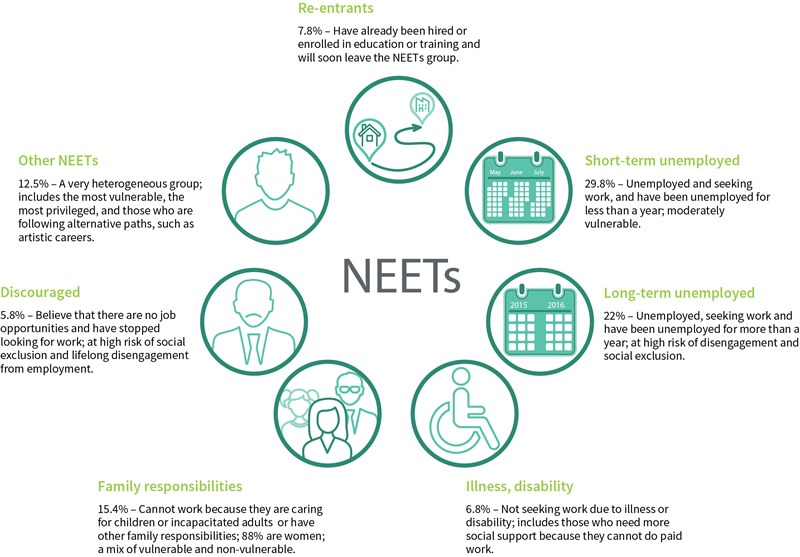EU context
Il concetto è stato ampiamente utilizzato come indicatore per informare politiche orientate ai giovani sull’occupabilità, l’istruzione, la formazione e l’inclusione sociale nei 28 Stati membri dell’UE dal 2010.
I NEET sono stati espressamente citati per la prima volta nelle discussioni politiche europee dell’iniziativa faro "Youth on the move" (gioventù in movimento) di Europa 2020. La fascia di età coperta dal termine era quella dei 15-24 anni, in seguito ampliata per includere le persone di età compresa tra 15 e 29 anni. Il concetto è ora integrato a livello centrale nel dibattito politico su scala europea. A oggi i NEET sono il 14,2 % della popolazione di età compresa tra 15 e 29 anni.
Nell’aprile 2013 è stata adottata la proposta della Commissione europea al Consiglio dell’Unione europea di attuare una Garanzia per i giovani in tutti gli Stati membri. Ridurre il numero di NEET è un obiettivo politico esplicito della Garanzia per i giovani. Questa iniziativa mira a garantire che tutti i giovani di età compresa tra i 15 e i 24 anni ricevano un’offerta di lavoro di qualità, formazione continua, apprendistato o tirocinio entro quattro mesi dalla disoccupazione o dal completamento dell’istruzione formale. La diffusione di Garanzia per i giovani negli Stati membri, attraverso l’iniziativa Occupazione giovanile, ha contribuito a migliorare la situazione sul campo, riducendo il numero di NEET.
Più di recente, il 7 dicembre 2016, la Commissione europea ha lanciato l’iniziativa Investire nei giovani d’Europa, un rinnovato sforzo volto a sostenere i giovani. Dato l’effetto positivo dell’iniziativa Garanzia per i giovani fino ad oggi, la Commissione intende promuovere e incrementare i finanziamenti disponibili per l’iniziativa Occupazione giovanile fino al 2020 al fine di incoraggiare una maggiore diffusione tra i giovani.
Il lavoro di Eurofound
Con l’attuazione di Garanzia per i giovani, il numero di NEET tra 15 e 29 anni è leggermente diminuito, passando da circa 14 milioni al culmine della crisi a 12,5 milioni nel 2016 (14,2 %). Tuttavia, la ricerca Eurofound stima ancora che la perdita significativa per le economie europee sia di circa 142 miliardi di EUR l’anno (2015) in benefici e profitti e imposte non riscosse, con un impatto significativo sullo sviluppo economico e sociale dell’UE.
Contributi chiave
A oggi, Eurofound ha aperto la strada a una vasta ricerca sui NEET (v. pubblicazioni di seguito) e ha:
- effettuato la prima analisi comparativa dell’UE sui NEET
- spiegato chi sono i NEET
- stimato i costi economici dei NEET
- esaminato le conseguenze sociali dell’essere NEET
- stimato i fattori di rischio correlati alla possibilità di rientrare nella categoria NEET
- esaminato l’efficacia delle politiche per il reinserimento dei NEET
- monitorato l’attuazione di Garanzia per i giovani.
Eterogeneità dei NEET
Nell’ambito di questa ricerca, Eurofound ha cercato di chiarire l’eterogeneità della popolazione NEET. L’ultimo studio sull’eterogeneità di tale categoria fornisce una nuova ripartizione in sette sottogruppi al fine di comprendere meglio la composizione di questo gruppo di giovani. L’obiettivo è di aiutare meglio i decisori politici a comprendere chi sono i NEET contribuendo alla formulazione di misure di sostegno adeguate per soddisfare un’ampia varietà di esigenze. Ciascuno di questi gruppi è costituito da un mix di giovani vulnerabili e non vulnerabili che non accumulano capitale umano attraverso canali formali, volontariamente o involontariamente.
Altri argomenti di ricerca
Oltre allo studio di cui sopra, negli ultimi anni Eurofound ha esaminato (v. pubblicazioni di seguito):
- le caratteristiche e i valori dell’imprenditoria giovanile;
- le strategie per il coinvolgimento della "categoria di mezzo mancante": giovani con istruzione di secondo grado che non seguono percorsi accademici nell’istruzione superiore;
- l’inclusione sociale dei giovani;
- le transizioni dei giovani nel mercato del lavoro;
- l’aumento dell’occupazione temporanea tra i giovani e l’accesso alla previdenza sociale;
- le condizioni di lavoro dei giovani che accedono al mercato del lavoro;
- i recenti sviluppi politici relativi ai NEET.
Si veda la lista di pubblicazioni qui di seguito.
Approfondimento: ricerche sull’eterogeneità dei NEET
4 luglio 2016 Sulla scia della relazione del 2012 di Eurofound NEET - Giovani non occupati, questa relazione esamina l’eterogeneità dei NEET proponendo sette sottogruppi in cui la popolazione NEET può essere suddivisa in base ai dati tratti dall’indagine sulla forza lavoro dell’UE del 2013. Questa suddivisione in sottogruppi consente un’analisi migliore di come le politiche, il clima sociale e il lento ma graduale miglioramento del mercato del lavoro hanno inciso sulla popolazione NEET dell’UE a 28. Aiutano inoltre a capire cosa si può fare per affrontare i problemi quale quello, ad esempio, dei disoccupati di lunga durata che rappresentano il 22 % dei NEET di età compresa tra i 15 e i 24 anni. Sono disponibili anche i 28 profili nazionali sull’eterogeneità dei NEET che offrono una panoramica della loro situazione per ogni Stato membro, esaminando le tendenze della disoccupazione giovanile e i numeri dei NEET, le composizioni di tale gruppo e il relativo rischio di esclusione sociale.
Ricerche sull’eterogeneità dei NEET
Infografica dei NEET













